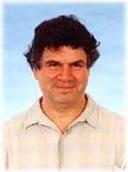
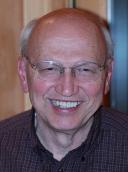
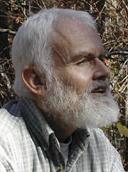
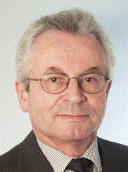
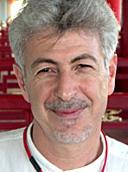
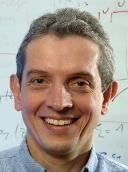

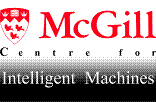
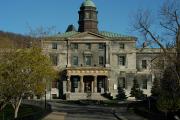
|
Ultrasound Guidance for Robotic Intracardiac Surgery To treat defects within the heart, surgeons currently use stopped-heart techniques. These procedures are highly invasive and incur a significant risk of neurological impairment. We are developing methods for performing surgery within the heart while it is beating. New real-time 3-D ultrasound imaging allows visualization through the opaque blood pool, but this imaging modality poses difficult image processing challenges, including poor resolution, acoustic artifacts, and data rates of 30 to 40 million voxels per second. To track instruments within the heart we have developed a Radon transform-based algorithm, which is readily implemented in real-time on graphics processor units. For manipulation of rapidly moving cardiac tissue we have created a fast robotic device that can track the tissue based on ultrasound image features. This allows the surgeon to interact with the heart as if it was stationary. To integrate ultrasound imaging with the robotic device we have developed a predictive controller that compensates for the 50-100 ms imaging and image processing delays to ensure good tracking performance. In vivo studies show that this approach enhances dexterity and lowers applied forces. Clinical applications of this technology include atrial septal defect closure and mitral valve annuloplasty. |
|
A year-long seminar series on the topic “Brain, Body and Machine,” where we intend to host five public lectures, each by a prominent international academic. We anticipate hosting seminars throughout the year, and up to December 2010. |
Seminars on “Brain, Body and Machine” |
|
Prof. Robert D. Howe — February 2, 2010
School of Engineering and Applied Sciences Harvard University, Cambridge, Massachusetts, USA
11:30 a.m., Room G-10 , Macdonald-Harrington Building |
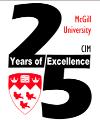
|
Centre for Intelligent Machines |
|
McGill University |
|
25 Years of Excellence |

|
The Future of Robotics - An Artificial Intelligence Perspective: Over the past years, the robotics community has steadily grown; an impressive number of systems, techniques, and applications have been developed. In this presentation, the broad vision of robotics will be first introduced, then, the principles and basis of several problems and example solutions in the development of autonomous robots will be given. Potential innovations that can be expected in the near future in this area will also be outlined. Several aspects of outstanding problems which make the development of truly autonomous robots challenging will be discussed, and key technologies that can have significant influence on the field of robotics will be highlighted. |
|
Prof. Dr. Wolfram Burgard — April 9, 2010
Faculty for Applied Sciences University of Freiburg, Germany
11:30 a.m., Room MD280 , Macdonald Engineering Building |
|
Robots among Humans: (For video click here) Robotics is rapidly expanding into the human environment and vigorously engaged in its new emerging challenges. From a largely dominant industrial focus, robotics has undergone, by the turn of the new millennium, a major transformation in scope and dimensions. This expansion has been brought about by the maturity of the field and the advances in its related technologies to address the pressing needs for human-centered robotic applications. Interacting, exploring, and working with humans, the new generation of robots will increasingly touch people and their lives, in homes, workplaces, and communities, providing support in services, entertainment, education, health care, and assistance. The discussion focuses on new design concepts, novel sensing modalities, efficient planning and control strategies, modeling of human motion and skills, which are among the key requirements for safe, dependable, and competent robots. |
|
Prof. Oussama Khatib — April 23, 2010
Department of Computer Science
6:00 p.m. Room G-10 , Macdonald-Harrington Building |
|
Sponsored by:
Department of Electrical & Computer Engineering |
|
Sponsored by:
School of Computer Science |
|
Sponsored by:
School of Computer Science
Department of Mechanical Engineering |
|
On Biological and Artificial Walking Walking is a fascinating invention of nature. It is versatile, flexible and perfectly adapted to a natural environment. Walking in its various realizations enables the biological systems to have access to all natural structures of the earth. Walking realizes motion, and motion with motion planning is the basis for intelligence, as modern biologists say. If intelligence is defined as the ability to deal with unknown and new situations biological motion, both mental and physical, can be considered as a manifestation of intelligence. Walking has been detected by engineers some 20-30 years ago, although before that time numerous trials had been made to realize some mechanisms with walking capabilities. Nowadays the computer age and a large variety of sophisticated technologies give walking machine realizations a high probability of success, which can best be seen in Japan. My group at the Technical University of Munich started in 1989 to design and to realize walking machines, partly in cooperation with neurobiologists specialized in biological walking problems. The presentation will touch some problems connected with machine walking, especially in the fields of design, dynamics, control and stabilization. It will also discuss some of the open questions connected with walking, especially stabilization problems. Finally, the chances of walking machines will be discussed. |
|
Prof. Friedrich Pfeiffer — September 10, 2010
Technical University Munich Angewandte Mechanik, Germany
5:30 p.m. Room G-10 , Macdonald-Harrington Building |
|
Sponsored by:
Department of Mechanical Engineering |
|
I will describe how simple stochastic differential equations can model evidence accumulation and decision making, sketching their derivation from biophysically-detailed models of spiking neurons, and relating them to the sequential probability ratio test from statistical decision theory. This connection yields a speed-accuracy tradeoff that optimizes rewards in a simple two-alternative perceptual decision task. I will compare the resulting model predictions with human behavior and advance explanations for failures to optimize. Finally, I will show how drift-diffusion models can be extended to describe choices in a social gambling task in which players receive limited information regarding other group members' choices and rewards. |
|
Prof. Philip Holmes — October 7, 2010
Department of Mechanical and Aerospace Engineering Princeton University, Princeton, NJ, USA
4:00 p.m. Room 1100, Trottier Building |
|
Sponsored by:
Department of Electrical & Computer Engineering
Department of Mechanical Engineering |
|
What is an Intelligent Machine? One of the weak points of the long debated Turing definition of machine intelligence is that it is based completely on language. Even though animals that appear not to use language exhibit behavior thought to be intelligent, Turing's definition leaves them out of the picture. Of even more importance, Turing's test occurs in an entirely sterile environment, providing no acknowledgment of the skills required to make use of the environment to solve problems. In this talk it will be argued that a definition of machine intelligence based on the degree to which machines are able to solve problems by partnering with their environment serves us better in our efforts to understand "intelligence" in a robotic context. This partnership may include using the environment to supplement motor skills, to calibrate capabilities, to test the accuracy of memory, and to experiment with possible courses of action. We intend to give arguments that support the idea that a machine can be said to be intelligent if, when it is placed in a partially unknown environment, it is able to extract sufficient tools and information from the environment to enable it to achieve its goals. The practical implications of this point of view for the design of robots will be emphasized.
|
|
Prof. Roger Brockett — October 29, 2010
School of Engineering and Applied Sciences Harvard University, Cambridge, Massachusetts, USA
6:00 p.m. Room 0100, Trottier Engineering Building |
|
Sponsored by:
Beatty Committee
Faculty of Engineering
Faculty of Science |
|
Optimal Mass Transport for Image Registration and Brain Warping In this talk, we will outline some recent work using the theory of optimal mass transport for surface warping and image registration. The mass transport problem was first formulated by Gaspar Monge in1781, and concerned finding the optimal way, in the sense of minimal transportation cost, of moving a pile of soil from one site to another. This problem was given a modern formulation in the work of Kantorovich, and is now known as the "Monge-Kantorovich problem." The registration problem is one of the great challenges that must be addressed in order to make image- guided surgery a practical reality. Registration is the process of establishing a common geometric reference frame between two or more data sets obtained by possibly different imaging modalities. In the context of medical imaging, this is an essential technique for improving preoperative and intraoperative information for diagnosis and image-guided therapy. Registration has a substantial recent literature devoted to it, with numerous approaches effective in varying situations, and ranging from optical flow to computational fluid dynamics to various types of warping methodologies. The method we discuss in this talk is designed for elastic registration, and is based on an optimization problem built around the L2 Monge-Kantorovich distance taken as a similarity measure. The constraint that we put on the transformations considered is that they obey a mass preservation property. Thus, we are matching "mass densities" in this method, which may be thought of as weighted areas in 2D or weighted volumes in 3D. We will assume that a rigid (non-elastic) registration process has already been applied before applying our scheme. Our method has a number of distinguishing characteristics. It is parameter free. It utilizes all of the gray-scale data in both images, and places the two images on equal footing. It is thus symmetrical, the optimal mapping from image A to image B being the inverse of the optimal mapping from B to A. It does not require that landmarks be specified. The minimizer of the distance functional involved is unique; there are no other local minimizers. Finally, it is specifically designed to take into account changes in density that result from changes in area or volume. We believe that this type of elastic warping methodology is quite natural in the medical context where density can be a key measure of similarity, e.g., when registering the proton density based imagery provided by MR. It also occurs in functional imaging, where one may want to compare the degree of activity in various features deforming over time, and obtain a corresponding elastic registration map. A special case of this problem occurs in any application where volume or area preserving mappings are considered. |
|
Prof. Allen R Tannenbaum — January 21, 2011
School of Electrical and Computer Engineering Georgia Tech, Atlanta, GA, USA
|
|
Sponsored by:
Department of Electrical & Computer Engineering
School of Computer Science |
